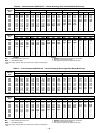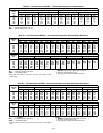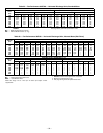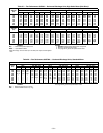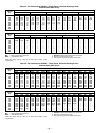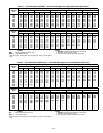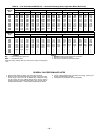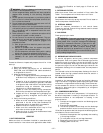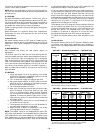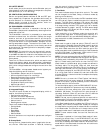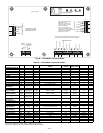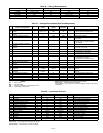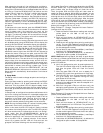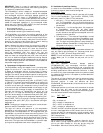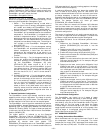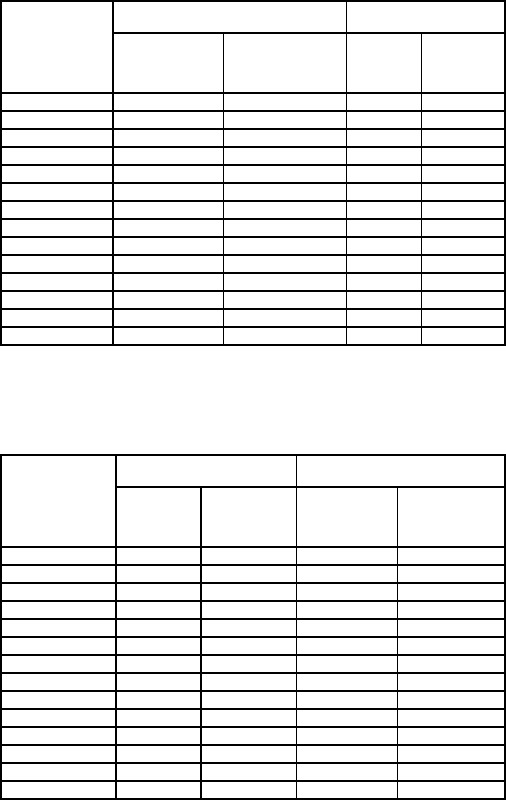
—38—
The suction and discharge pressure levels should now move
to their normal start-up levels.
NOTE: When the compressor is rotating in the wrong direc-
tion, the unit makes an elevated level of noise and does not
provide cooling.
IX. COOLING
Set space thermostat to OFF position. To start unit, turn on
main power supply. Set system selector switch at COOL posi-
tion and fan switch at AUTO. position. Adjust thermostat to
a setting below room temperature. Compressor, outdoor fan
and evaporator motor start on closure of contactor.
Check unit charge. Refer to Service, Refrigerant Charge sec-
tion, page 48.
Reset thermostat at a position above room temperature.
Compressor will shut off. Evaporator fan will shut off after
30-second delay.
To Shut Off Unit
Set system selector switch at OFF position. Resetting ther-
mostat at a position above room temperature shuts unit off
temporarily until space temperature exceeds thermostat
setting.
X. MAIN BURNERS
Main burners are factory set and should require no
adjustment.
TO CHECK ignition of main burners and heating controls,
move thermostat set point above room temperature and ver-
ify that the burners light and evaporator fan is energized.
After ensuring that the unit continues to heat the building,
lower the thermostat setting below room temperature and
verify that the burners and evaporator fan turn off. (Fan will
turn off only if fan selector switch is in the AUTO. position.)
Refer to Table 34A and 34B for the correct orifice to use at
high altitudes.
XI. HEATING
1. Purge gas supply line of air by opening union ahead
of gas valve. If gas odor is detected, tighten union and
wait 5 minutes before proceeding.
2. Turn on electrical supply and manual gas valve.
3. Set system switch selector at HEAT position and fan
switch at AUTO. or ON position. Set heating temper-
ature lever above room temperature.
4. The induced-draft motor will start.
5. After a call for heating, the main burners should light
within 5 seconds. If the burner does not light, then
there is a 22-second delay before another 5-second
try. If the burner still does not light, the time delay is
repeated. If the burner does not light within 15 min-
utes, there is a lockout. To reset the control, break the
24-v power to W1.
6. The evaporator-fan motor will turn on 45 seconds af-
ter the burners are ignited.
7. The evaporator-fan motor will turn off 45 seconds af-
ter thermostat temperature is satisfied.
8. Adjust airflow to obtain a temperature rise within
the range specified on the unit nameplate.
NOTE: The default value for the evaporator-fan motor ON/
OFF delay is 45 seconds. The Integrated Gas Unit Controller
(IGC) modifies this value when abnormal limit switch cycles
occur. Based upon unit operating conditions, the ON delay can
be reduced to 0 seconds and the OFF delay can be extended
to 180 seconds. When one flash of the LED is observed, the
evaporator-fan ON/OFF delay has been modified.
If the limit switch trips at the start of the heating cycle dur-
ing the evaporator ON delay, the time period of the ON delay
for the next cycle will be 5 seconds less than the time at
which the switch tripped. (Example: If the limit switch trips
at 30 seconds, the evaporator-fan ON delay for the next cycle
will occur at 25 seconds.) To prevent short-cycling, a 5-second
reduction will only occur if a minimum of 10 minutes has
elapsed since the last call for heating.
The evaporator-fan OFF delay can also be modified. Once the
call for heating has ended, there is a 10-minute period dur-
ing which the modification can occur. If the limit switch trips
during this period, the evaporator-fan OFF delay will
increase by 15 seconds. A maximum of 9 trips can occur,
extending the evaporator-fan OFF delay to 180 seconds.
To restore the original default value, reset the power to the
unit.
To Shut Off Unit
Set system selector switch at OFF position. Resetting heat-
ing selector lever below room temperature will temporarily
shut unit off until space temperature falls below thermostat
setting.
Table 34A — Altitude Compensation* — Standard Units
*As the height above sea level increases, there is less oxygen per cubic foot of air.
Therefore, heat input rate should be reduced at higher altitudes.
†Orifices available through your Bryant distributor.
Table 34B — Altitude Compensation* — Low NOx Units
*As the height above sea level increases, there is less oxygen per cubic foot of
air. Therefore, the input rate should be reduced at higher altitudes.
†Orifices are available through your local Bryant distributor.
ELEVATION
(ft)
74,000 AND 115,000 BTUH
NOMINAL INPUT
150,000 BTUH
NOMINAL INPUT
Natural
Gas
Orifice
Size†
Liquid
Propane
Orifice
Size†
Natural
Gas
Orifice
Size†
Liquid
Propane
Orifice
Size†
0-2,000 33 43 30 37
2,000 36 44 31 39
3,000 36 45 31 40
4,000 37 45 32 41
5,000 38 46 32 42
6,000 40 47 34 43
7,000 41 48 35 43
8,000 42 49 36 44
9,000 43 50 37 45
10,000 44 50 39 46
11,000 45 51 41 47
12,000 46 52 42 48
13,000 47 52 43 49
14,000 48 53 44 50
ELEVATION
(ft)
60,000 AND 90,000 BTUH
NOMINAL INPUT
120,000 BTUH
NOMINAL INPUT
Natural
Gas
Orifice
Size†
Liquid
Propane
Orifice
Size†
Natural
Gas
Orifice
Size
Liquid
Propane
Orifice
Size†
0-2,000 38 45 32 42
2,000 40 47 33 43
3,000 41 48 35 43
4,000 42 49 36 44
5,000 43 49 37 45
6,000 43 50 38 45
7,000 44 50 39 46
8,000 45 51 41 47
9,000 46 52 42 48
10,000 47 52 43 49
11,000 48 53 44 50
12,000 49 53 44 51
13,000 50 54 46 52
14,000 51 54 47 52



